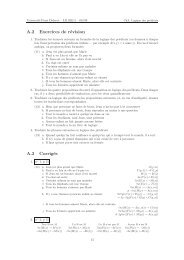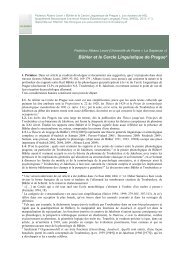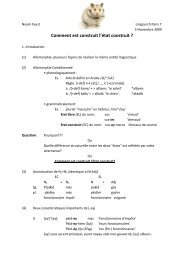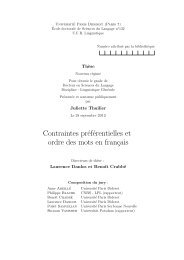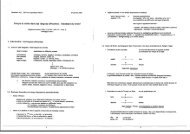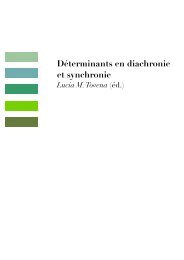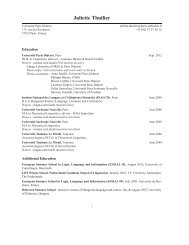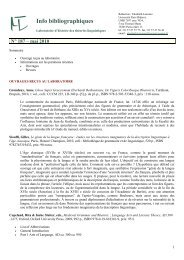Encoding path in Mauritian Creole and Bhojpuri - Laboratoire de ...
Encoding path in Mauritian Creole and Bhojpuri - Laboratoire de ...
Encoding path in Mauritian Creole and Bhojpuri - Laboratoire de ...
Create successful ePaper yourself
Turn your PDF publications into a flip-book with our unique Google optimized e-Paper software.
Sibylle Kriegel, Ralph Ludwig & Fabiola Henri<strong>Encod<strong>in</strong>g</strong> <strong>path</strong> <strong>in</strong> <strong>Mauritian</strong> <strong>Creole</strong> <strong>and</strong> <strong>Bhojpuri</strong> Concern<strong>in</strong>g the question of mutual <strong>in</strong>telligibility between H<strong>in</strong>di <strong>and</strong> <strong>Mauritian</strong><strong>Bhojpuri</strong>, 11 it is important to specify that many <strong>Mauritian</strong> <strong>Bhojpuri</strong> speakers arealso speakers of or have a (passive) competence <strong>in</strong> H<strong>in</strong>di, 12 especially s<strong>in</strong>ce youngergenerations learn H<strong>in</strong>di as heritage language at school <strong>and</strong> a majority of <strong>Mauritian</strong><strong>Bhojpuri</strong> speakers have access to televised programs <strong>in</strong> H<strong>in</strong>dustani (H<strong>in</strong>di/Urdu).Thus, there is mutual comprehension, at least among certa<strong>in</strong> speakers, <strong>and</strong> equallya permanent contact between H<strong>in</strong>di <strong>and</strong> <strong>Bhojpuri</strong> <strong>in</strong> Mauritius.Contact between <strong>Mauritian</strong> <strong>Creole</strong> <strong>and</strong> <strong>Bhojpuri</strong> <strong>Creole</strong> <strong>in</strong>fluences on <strong>Bhojpuri</strong>Generally speak<strong>in</strong>g, the ten<strong>de</strong>ncy to replace marked features by unmarked ones(mentioned above) can be attributed either to the <strong>in</strong>fluence of <strong>Creole</strong> or tothe laws of orality which show a ten<strong>de</strong>ncy towards generaliz<strong>in</strong>g the unmarkedform <strong>and</strong> which also govern (historical) creolization <strong>and</strong> the use of <strong>Bhojpuri</strong> <strong>in</strong>Mauritius. 13However, the <strong>in</strong>fluence of <strong>Creole</strong> on <strong>Bhojpuri</strong> is clearly evi<strong>de</strong>nt <strong>in</strong> the area oflexis. As will be shown <strong>in</strong> the follow<strong>in</strong>g examples, <strong>Mauritian</strong> <strong>Bhojpuri</strong> makes useof several <strong>Creole</strong> borrow<strong>in</strong>gs. 14(2) a. <strong>Mauritian</strong> <strong>Bhojpuri</strong>Bazaar se pom anye.market apple br<strong>in</strong>gb. <strong>Mauritian</strong> <strong>Creole</strong>Amenn enn pom <strong>de</strong>pi bazar.br<strong>in</strong>g apple market‘Br<strong>in</strong>g an apple from the market.’These processes of borrow<strong>in</strong>g <strong>in</strong>clu<strong>de</strong> the use of entire phrases which seem tobecome complex lexical items <strong>in</strong> <strong>Bhojpuri</strong>:(3) 15 a. <strong>Mauritian</strong> <strong>Bhojpuri</strong>Ham danbwa se nikla tha<strong>in</strong>.1 forest come.from ..1b. <strong>Mauritian</strong> <strong>Creole</strong>Mo sorti dan bwa.1 come.from forest.‘I come from the forest.’However, <strong>in</strong> the area of lexis, the extent to which <strong>Bhojpuri</strong> words are replaced by<strong>Creole</strong> equivalents varies accord<strong>in</strong>g to geographical (urban versus rural areas)<strong>and</strong> age differences. Evi<strong>de</strong>ntly, urban <strong>and</strong> younger speakers use <strong>Creole</strong> wordsmore frequently than rural or ol<strong>de</strong>r speakers. Thus, two sociol<strong>in</strong>guistic factorsare shown to be important when consi<strong>de</strong>r<strong>in</strong>g the evolution of the l<strong>in</strong>guistic ecosystemof Mauritius: urbanization <strong>and</strong> diagenerational variation. 16 Here, we willmerely make reference to these few examples concern<strong>in</strong>g lexis <strong>and</strong> will return tothe possible reciprocal <strong>in</strong>fluences on morphosyntax <strong>in</strong> the follow<strong>in</strong>g paragraph, aswell as <strong>in</strong> §3. Cf. Dom<strong>in</strong>gue’s (1981: 52) comment concern<strong>in</strong>g l<strong>in</strong>guistic awareness: “<strong>Mauritian</strong> <strong>Bhojpuri</strong>is so different from Cont<strong>in</strong>ental <strong>Bhojpuri</strong> that its speakers are not really sure that they are, <strong>in</strong><strong>de</strong>ed,speak<strong>in</strong>g that language. In fact, most of them believe that they speak some patois of H<strong>in</strong>di, verymuch like <strong>Mauritian</strong> <strong>Creole</strong> speakers believe that they speak a patois of French”. If this analysisrema<strong>in</strong>s true for many ol<strong>de</strong>r speakers, the attitu<strong>de</strong>s of younger generations of speakers havenevertheless changed <strong>in</strong>sofar as they draw a dist<strong>in</strong>ction between <strong>Bhojpuri</strong> “language of the ol<strong>de</strong>rgeneration” for many, <strong>and</strong> H<strong>in</strong>di, prestige language learnt at school. Our <strong>in</strong>formants clarify that those who studied H<strong>in</strong>di at school up to CPE (end of primaryeducation) have passive competence, i.e., they un<strong>de</strong>rst<strong>and</strong> but do not speak H<strong>in</strong>di. Those whostudy H<strong>in</strong>di <strong>in</strong> high school have an active competence. Thus Baker & Ramnah (1985: 219 ff) mention that the function of the unmarked form ofthe noun <strong>in</strong> <strong>Mauritian</strong> <strong>Bhojpuri</strong> corresponds exactly to that of the <strong>Creole</strong> Prototype. Howeverthey are unable to <strong>de</strong>term<strong>in</strong>e whether this parallel is truly due to a <strong>Creole</strong> <strong>in</strong>fluence. Baker & Ramnah (1985: 226) estimate some 1000 <strong>Creole</strong> words <strong>in</strong> <strong>Mauritian</strong> <strong>Bhojpuri</strong>,cf. also Neerputh (1986: 11). Mesthrie (1991: 153) reports examples of the transfer of <strong>Creole</strong>lexemes to South African <strong>Bhojpuri</strong> via <strong>Mauritian</strong> <strong>Bhojpuri</strong>.2nd proofs <strong>Bhojpuri</strong> <strong>in</strong>fluence on <strong>Creole</strong>It has been shown that <strong>Bhojpuri</strong> has, for its part, left several lexical traces on <strong>Creole</strong>.Baker & Ramnah (1985: 226) cite a figure of more than 300 words of Indo-Aryanorig<strong>in</strong> <strong>in</strong> <strong>Mauritian</strong> <strong>Creole</strong>, of which the majority are probably from <strong>Bhojpuri</strong>(Kriegel & Ludwig & Henri forthcom<strong>in</strong>g).Dur<strong>in</strong>g our surveys, <strong>in</strong>formants brought to light the fact that certa<strong>in</strong> <strong>Bhojpuri</strong>words have been <strong>in</strong>tegrated <strong>in</strong>to <strong>Creole</strong>, some examples be<strong>in</strong>g: 17 karay (‘fry<strong>in</strong>g We are grateful to Kumari Issur, who provi<strong>de</strong>d us with this example <strong>and</strong> who also drew ourattention to the fact that dan-bwa as a s<strong>in</strong>gle word translates as “forest” <strong>and</strong> can even be replacedby lafore where <strong>Bhojpuri</strong> is used <strong>in</strong> contexts call<strong>in</strong>g for a higher register. It would seem, then,that <strong>Bhojpuri</strong> borrows lexical items (lexemes) from various <strong>Creole</strong> registers. For more <strong>de</strong>tailed analysis of these factors, see Díaz & Ludwig & Pfän<strong>de</strong>r (2002). See Baker (1982: 314 ff.) for a methodical summary <strong>in</strong> which some of these words arefound.



